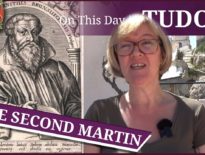On this day in Tudor history, 9th April 1582, Richard Bertie, member of Parliament, evangelical, and second husband of Catherine Willoughby (other married name Brandon), Duchess of Suffolk, died at Bourne in Lincolnshire. He was laid to rest in St James’s Church, Spilsby, with Catherine, who had died in 1580.
Bertie was Catherine's gentleman usher and the two became close following the death of her sons from sweating sickness.
Find out more about the man Catherine Willoughby chose to marry for love in today's talk from Claire Ridgway.
You can see their splendid tomb at https://www.geograph.org.uk/photo/2736462
You can find out more about Catherine Willoughby in this video
Also on this day in Tudor history, 9th April 1533, Catherine of Aragon was informed that she was no longer queen. Find out what happened in last year’s video:
Also on this day in history:
- 1483 – Death of Edward IV at the Palace of Westminster. He was laid to rest in St George's Chapel, Windsor Castle, on 20th April. His cause of death is unknown. It may have been caused by a chill, but he was known for overindulging in food and drink, and that would not have helped his health.
- 1557 – Cardinal Reginald Pole's legatine powers were revoked by Pope Paul IV.
- 1590 – Funeral of Ambrose Dudley, Earl of Warwick. He was laid to rest in the Beauchamp Chapel of St Mary's Church, Warwick.
- 1626 – Death of Francis Bacon, Viscount St Alban, Lord Chancellor, politician and philosopher. It appears that Bacon died from inhaling nitre or opiates in a botched experiment.
Transcript:
On this day in Tudor history, 9th April 1582, Richard Bertie, member of Parliament, evangelical, and second husband of Katherine Willoughby (other married name Brandon), Duchess of Suffolk, died at Bourne in Lincolnshire. He was laid to rest in St James’s Church, Spilsby, with Katherine, who had died in 1580. Their memorial can still be seen today in the church’s Willoughby Chapel.
Here are a few facts about this Tudor man:
• Richard Bertie was born in 1517 and was the eldest son of stonemason Thomas Bertie of Kent.
• He was educated at Corpus Christi College, Oxford, and graduated from there with a BA in 1537. He was then a probationary fellow at Magdalen College for two years.
• Following that, he was employed in the household of Thomas Wriothesley, Lord Chancellor to King Henry VIII, and then that of Katherine Willoughby, widow of Charles Brandon, Duke of Suffolk. He served Katherine as gentleman usher, an important role when the duchess had large households in Lincolnshire and London, and lots of business that needed dealing with. Bertie became known for his wit and his gift for languages – French, Italian and Latin.
• It appears that Katherine and Bertie became close following the deaths of her sons, Henry and Charles, from sweating sickness in July 1551. They married in around 1552.
• Bertie and Katherine were both Protestants and in June 1554 Bertie was summoned by Bishop Stephen Gardiner, Queen Mary I’s Lord Chancellor, who asked him if he and his wife, were ready to return to the Catholic fold. Gardiner apparently asked Bertie if Katherine, who was of Spanish Catholic stock, was “now as ready to set up the mass, as she was lately to pull it down. Bertie and Katherine were firm in their Protestant faith, and Katherine had made an enemy of Gardiner, so they decided to flee into exile. Bertie went abroad first, to sort things out, and Katherine and their infant daughter, Susan, followed him in 1555. They moved from Wesel (veezel), where their son, Peregrine, was born in 1555, to Strasbourg, to Frankfurt, where they were nearly murdered, and finally to Poland, where they settled after being offered refuge there by King Sigismund Augustus. They returned to England in 1559 following Elizabeth I’s accession.
Their son’s name, Peregrine, means “one from abroad”, and referred to his birth in exile.
• Back in England, Bertie set about writing an answer to Scottish Reformer John Knox’s polemical work, “The First Blast of the Trumpet Against the Monstruous Regiment of Women”, in which Knox attacked female rulers arguing that their rule was contrary to the Bible. It was written for private circulation only.
• The couple were not favoured in Elizabeth I’s reign due to Katherine’s religious zeal, and they settled in Lincolnshire, on Katherine’s estates there.
• In 1563, Bertie served as a Member of Parliament for Lincolnshire, and in 1564 and 1565 he served as sheriff of the county. These were all local positions away from court.
• He was granted an honourary Masters from Cambridge in 1564 while attending the queen who was there on progress.
• Bertie’s biographer, Susan Wabuda, writes of how Bertie was overshadowed by his more famous wife and that “He continued to serve her interests, especially in attempting to gain recognition of her claim to the barony of Willoughby of Eresby (Ersby), which she wished to enjoy as the sole heir of her father, William Willoughby, eleventh Lord Willoughby.” In 1570, he put forward a formal claim to the queen for him to hold the title in his wife’s right, but Elizabeth I did nothing about it until after Katherine’s death in 1580, when she granted it to the couple’s son, Peregrine.
• Bertie’s son, Peregrine, 13th Baron Willoughy, served Elizabeth I as a soldier and diplomat and was married to Mary de Vere, daughter of the Earl of Oxford, and Bertie’s daughter, Susan, married Reginald Grey of Wrest, 5th Earl of Kent, and then Sir John Wingfield.
• A huge alabaster memorial to Richard and Katherine Bertie can still be seen today at St James’s Church Spilsby and it features recumbent effigies of the couple, along with a wildman of the woods, a Saracen king and a hermit carrying a staff and prayer bead. These are all Willoughby badges. It is thought that Bertie himself designed the tomb.



Leave a Reply